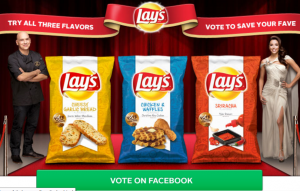Chicken and Waffles potato chips anyone? If that’s not your cup of tea, perhaps Cheesy Garlic Bread or Sriracha flavored chips will spark your interest. Executives at Frito-Lay sure hope so, as the company has promised a handsome one million dollar reward, or 1% of net sales, to the creator of the newest Lay’s potato chip flavor that garners the most votes via Facebook. Oh, and the campaign features the beautiful Eva Longoria pretending that she eats potato chips and celebrity chef Michael Symon pretending that he is not appalled by crowd suggestions.
My head is spinning. I’m not sure which implied marketing strategy to focus on! But I must pick the one that intrigues me most. Crowdsourcing, a term coined by Jeff Howe in a 2006 Wired article, describes the genius practice of soliciting the public to perform a task for a company. It’s becoming an increasingly popular practice, popping up across all kinds of industries, from books to beer.
Frito-lay jumped on the band wagon last summer with a crowdsourcing project that is currently in-progress. In July of 2012 the public was approached by the company via a massive social media campaign to “Do us a flavor,” by concocting ideas for the brands newest potato chip offering. Now, let’s be honest, the marketing execs at Frito-Lay, in no way, thought it cost-effective to sift through what would turn out to be 3.8 million submissions just for a potato chip flavor concept. So, what’s the upside to this elaborate and costly crowdsourcing campaign? Marketing gold.
Utilizing free and ever-popular social media to conduct the quest ensured massive reach on the cheap. Engaging the public in such an interactive way is almost guaranteed to boost the company’s brand image. Not to mention that now that the flavor finalists have been determined, consumers have to purchase, not one, but three bags of Lay’s in order to make a knowledgeable decision before casting their vote via Facebook, Twitter or the company’s website. After all, what’s worse than an uninformed voter? But beyond all of this, the sheer amount of interest that this campaign has generated is staggering. People everywhere are talking about which flavor should win and creating their own mini-marketing campaigns for their favorite. It might not even matter if the snack chip flavors taste any good, for the amount of marketing hype they are creating for Lays. (Some examples here and here.)
This is not to suggest that the innovative marketing tool doesn’t have its downfalls. In an insightful Forbes article, Larissa Faw asks the questions, “Are millennials crowdsourcing themselves out of jobs?” and suggests that the cost-saving practice of crowdsourcing projects that would otherwise expend company resources may eventually endanger employment opportunities.
I have to say, after delving a bit deeper into the details of Frito-Lay’s campaign, I think our jobs are safe. Not only did the company invest a great deal of time and money into marketing the crowdsourcing project itself, they also produced the final three products for mass distribution and created individual marketing teams for each of the three flavors. When done on a massive scale, by a company as large as Frito-Lay crowdsourcing may create jobs. It certainly created partnerships, as seen in the sponsorship of the “Do us a Flavor” campaign by Target Stores. The mutually beneficial arrangement draws the public to Target in order to enter a sweepstakes for a chance to win a trip to Los Angeles and a meet and greet with Eva Longoria.
Companies with smaller marketing budgets may find real value in using crowdsourcing as an advertising tool. Combining this approach with the utilization of social media outlets seems to be the ideal marketing opportunity for growing companies looking to garner widespread buzz and some serious brand recognition.
Alexandra Murtha (CMGT541-A)


4 Responses to Frito-Lay: Bold Flavors to Match Bold Marketing